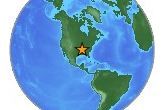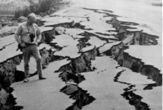New Data Confirms Strong Earthquake Risk to Central U.S.

A colossal earthquake that caused damage from South Carolina to Washington D.C. and temporarily reversed the course of the Mississippi River nearly two centuries ago could be repeated within the next 50 years, scientists said today.
Strain is building on a fault near Memphis, Tennessee that was the site of a magnitude 8.1 earthquake in 1812, according to new observations that settle a debate on the risk of another huge quake.
The odds of another 8.0 event within 50 years are between 7 and 10 percent, geologists said today. The assessment, based on new data from a recently installed array of sensors, puts to rest a 1990s claim that strain was not increasing.
Such a strong earthquake would rock the entire eastern half of the country and prove devastating to the local region. A lesser but still damaging quake of magnitude 6 or greater has a 90 percent chance of striking in the next five decades.
The new study, detailed in the June 23 issue of the journal Nature, reveals a vexing characteristic of the fault that traverses the region. The ground moves more near the fault, creeping a few millimeters every year, than it does farther from it.
"I can't explain how the movement is driven," said study team member Michael Ellis, a geologist at the University of Memphis.
That lack of understanding makes the task of pinpointing when the next quake might hit even more challenging.
Sign up for the Live Science daily newsletter now
Get the world’s most fascinating discoveries delivered straight to your inbox.
Repeating history
In a three-month period in 1811-12, three major earthquakes rattled a broad expanse of the United States, causing damage as far away as Charleston, South Carolina and even rattling nerves in Boston. The quakes triggered landslides into the Mississippi River and, according to some boaters who were not drowned, sent part of the river running the other direction for a time.
The earthquakes were centered around New Madrid, Missouri. They measured 8.1, 8.0 and 7.8 and represent three of the four strongest earthquakes ever recorded in the lower 48 states.
Over the past 12 years, geologists have found evidence for other prehistoric calamities along the New Madrid fault. Sandy soil in some areas became liquefied in past events, leaving telltale "sandblows" when the material was squished to the surface. This tendency for soil east of the Rockies to liquefy, along with other differences in geology, means earthquakes there pack more potential for damage and are felt over a much wider region than western temblors.
An earthquake East of the rockies is felt across a wider area. SOURCE: USGS
The sandblows indicate that three or possibly four earthquakes of magnitude 7.6 or better struck the region in the past 2,000 years, in addition to the incredible series of three in the early 1800s.
Strange movement
The new data show the ground indeed moves a few millimeters each year near the fault, as most geologists had expected. But away from the fault, the movement was discovered to be less. Ellis and his colleagues, including study leader Bob Smalley, speculate that well below the surface, the fault was displaced by the 1811-12 events and that shift is still, slowly, propagating upward.
Ellis cautioned, however, that more data is needed to figure out what?s going on.
Unlike California, the slow shift around New Madrid is not driven by the collision between major plates of Earth?s crust.
"Ultimately the movement is driven by plate tectonics, with the North American plate moving generally westward," says Martitia Tuttle, a geologist at M. Tuttle & Associates who was not involved in the new research.
Most scientists think the New Madrid fault is part of an ancient system of rifts embedded in the plate.
"The old rift system is a zone of weakness and therefore is more prone to failure, resulting in earthquakes, than surrounding regions," Tuttle told LiveScience.
The new study provides "scientific justification for the adoption of stricter earthquake provisions in the building codes for Memphis and other cities in the central United States," Tuttle said.
The results, and an analysis by Tuttle, are published in the June 23 issue of the journal Nature.
Sooner or later ...
The findings contradict a study in the 1990s, based on less data, that concluded the ground was not shifting and so strain buildup was minimal. Since that controversial work, scientists have debated the prevailing view that more major earthquakes are likely.
"Our results confirm the current status of seismic hazard ... that says that the likelihood of another 1811-12 earthquake in the next 50 years is between 7 and 10 percent," Ellis said in an email interview.
The chances of a smaller but still devastating temblor are higher.
"Strong earthquakes in the New Madrid seismic zone are certain to occur in the future," states a fact sheet from the U.S. Geological Survey. "There is a 9-in-10 chance of a magnitude 6 to 7 temblor occurring in the New Madrid Seismic Zone within the next 50 years."
The new monitoring system around the New Madrid fault should eventually allow geologists to refine their predictions.
"Folks out west, California in particular, are much further ahead than are we," Ellis said. "They have more data, more instrumentation, and a simpler tectonic environment. Our results though will begin to constrain the set of reasonable theoretical models for the generation of midplate earthquakes, and that's the beginning of making better forecasts."
Related Stories
- The Odds of Dying
- 101 Amazing Earth Facts
- Top 10 Ways to Destroy Earth
- Deadliest Earthquakes in History
- March is Earthquake Month, and Other Shaky 'Facts'
Only in California: Daily Earthquake Forecasts
Earth Puts Big Squeeze on Los Angeles
Central US Warned of Larger Earthquakes to Come
Ominous Rumbling Under San Andreas Fault
Seismologists Target Better Earthquake Prediction
Quake Death Toll in 2004 Could Be Worst Since 1556
Earthquakes Stopped, But Only In Lab
Image Gallery

Deadly Earthquakes
Robert is an independent health and science journalist and writer based in Phoenix, Arizona. He is a former editor-in-chief of Live Science with over 20 years of experience as a reporter and editor. He has worked on websites such as Space.com and Tom's Guide, and is a contributor on Medium, covering how we age and how to optimize the mind and body through time. He has a journalism degree from Humboldt State University in California.



